You searched for: victims
<< Previous | Displaying results 201-225 of 372 for "victims" | Next >>
-
Glossary
ArticleAntisemitism: hostility toward or hatred of Jews as a religious or ethnic group, often accompanied by social, economic, or political discrimination. Appellplatz: German word for roll call square where prisoners were forced to assemble. Aryan: Term used in Nazi Germany to refer to non-Jewish and non-Roma (Gypsy) Caucasians. Northern Europeans with especially "Nordic" features such as blonde hair and blue eyes were considered by so-called race scientists to be the most superior of Aryans, members of a…
-
Non-Jewish Resistance
ArticleA variety of non-Jewish groups and individuals resisted the Nazi regime, both in Germany and in German-occupied territory. Learn more.
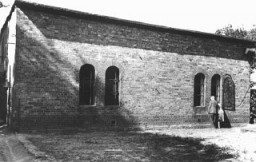
-
Political Prisoners
ArticleHitler's political opponents were the first victims of systematic Nazi persecution. They were incarcerated without trial and under conditions of great cruelty.

-
1944: Key Dates
ArticleExplore a timeline of key events during 1944 in the history of Nazi Germany, World War II, and the Holocaust.
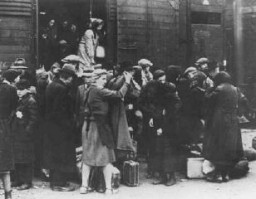
-
The Nazi Camp System: Terminology
ArticleWhat is the difference between a “concentration camp” and a “killing center”? Learn about the history of these terms and what they meant in the context of Nazi oppression and murder.
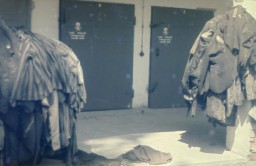
-
Sobibor: Key Dates
ArticleExplore a timeline of key events in the history of the Sobibor killing center in the General Government, the German-administered territory of occupied Poland.

-
Klaus Barbie: The Butcher of Lyon
ArticleKlaus Barbie, chief of the Gestapo in Lyon, France, was nicknamed the "Butcher of Lyon" for his brutal actions towards Jews and members of the French Resistance.
-
Operation Reinhard
Timeline EventOctober 15, 1941. On this date, Heinrich Himmler tasks SS Gen. Odilo Globocnik with implementing "Operation Reinhard."

-
An Overview of the Holocaust: Topics to Teach
ArticleRecommended resources, topics, context, rationale, and critical thinking questions if you have limited time to teach about the Holocaust.

-
Geography of the Holocaust
Media EssayThe Holocaust (1933–1945) was the systematic, state-sponsored persecution and murder of six million European Jews by the Nazi German regime and its allies and collaborators. The Holocaust era began in January 1933 when Adolf Hitler and the Nazi Party came to power in Germany. It ended in May 1945, when the Allied Powers defeated Nazi Germany in World War II. The Holocaust was a German initiative that took place throughout German- and Axis-controlled Europe. It affected nearly all of Europe’s Jewish…
-
Einsatzgruppen in Liepaja, Latvia
FilmGerman Einsatzgruppen operated in German-occupied territories in eastern Europe during World War II. This rare footage shows a unit during a massacre in Liepaja, Latvia. The film was taken, contrary to orders, by a German soldier. Before the war, the Jewish population of Liepaja stood at more than 7,000 residents. Einsatzgruppen shot almost the entire Jewish population of the town. When the Soviet army liberated the city in 1945, just 20 to 30 Jews remained. Einsatzgruppen carried out various security…

-
Photograph documenting medical experiments on a Polish prisoner in the Ravensbrück concentration camp
PhotoClandestine photograph of a Polish political prisoner and medical experiment victim in the Ravensbrück concentration camp. Prisoners in the Ravensbrück concentration camp took several clandestine photographs as evidence of the medical experiments conducted on them. The camp was the site of bone-grafting experiments and experiments to test newly developed sulfa drugs.Pictured here, Bogumila Jasuik was chosen as one of the 74 "rabbits" for medical experimentation. German doctors experimented…
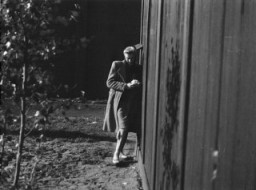
-
European rail system, 1939
MapThe European rail network played a crucial role in the implementation of the Final Solution. Jews from Germany and German-occupied Europe were deported by rail to killing centers in occupied Poland, where they were killed. The Germans attempted to disguise their intentions, referring to deportations as "resettlement to the east." The victims were told they were to be taken to labor camps, but in reality, from 1942 onward, deportation meant transit to killing centers for most Jews. Deportations on this…

-
Major deportations to killing centers, 1942-1944
MapAt the Wannsee Conference in Berlin in January 1942, the SS (the elite guard of the Nazi state) and representatives of German government ministries estimated that the "Final Solution," the Nazi plan to kill the Jews of Europe, would involve 11 million European Jews, including those from non-occupied countries such as Ireland, Sweden, Turkey, and Great Britain. Jews from Germany and German-occupied Europe were deported by rail to the killing centers in occupied Poland, where they were killed. The Germans…

-
Hanging of members of the Communist underground in Minsk
PhotoThe public hanging of three members of the Communist underground on Karl Marx Street in Minsk. One of the victims wears a large placard around his neck that reads "We are partisans and have shot at German soldiers."This execution was one of four carried out in Minsk on October 26, 1941, by German troops with the 707th Infantry Division. Altogether, 12 members of the Communist underground were publicly hanged in four groups of three near a yeast-making factory. This is believed to be the first public…
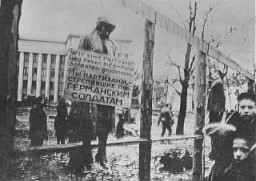
-
Soviet POW camp Belzen bei Bergen
PhotoPhotograph from a series taken by a guard in the Soviet prisoner-of-war camp of Belzen bei Bergen, and numbered in Roman numerals by the American officer, Lt. van Otten. The camp held approximately 10,000 POWs, most of whom came from Fallingbostel, 10 km away. When they fell ill, they were marched to Belsen. At Belsen, they were starved, often given only a soup made of field beets. This photo shows Soviet POWs assembled at the camp. Germany, 1941–45. Second only to the Jews, Soviet prisoners of war…
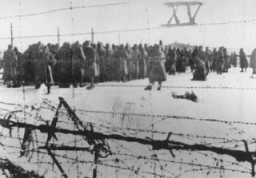
-
Auschwitz environs, summer 1944
MapAuschwitz was the largest camp established by the Germans. It was a complex of camps, including a concentration, extermination, and forced-labor camp. It was located at the town of Oswiecim near the prewar German-Polish border in Eastern Upper Silesia, an area annexed to Germany in 1939. Auschwitz I was the main camp and the first camp established at Oswiecim. Auschwitz II (Birkenau) was the killing center at Auschwitz. Trains arrived at Auschwitz-Birkenau almost daily with transports of Jews from…

-
Debate within the Lokacze Ghetto
ArticleDifficult debates took place within ghettos about whether and how to resist under the most adverse conditions. Read a rare account from the Lokacze ghetto.
-
German Railways and the Holocaust
ArticleThe European rail network played a crucial role in the implementation of the Final Solution. Millions were deported by rail to killing centers and other sites.
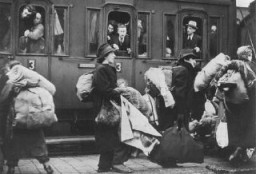
-
Plight of Jewish Children
ArticleDuring the Holocaust, some children went into hiding to escape Nazi persecution. They faced constant fear, dilemmas, and danger.
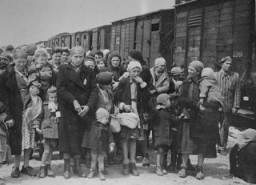
-
The Murder of People with Disabilities
ArticleAt the beginning of WWII, people with mental or physical disabilities were targeted for murder in what the Nazis called the T-4, or "euthanasia," program.
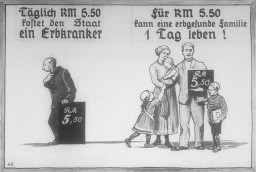
-
Jewish Life in Europe Before the Holocaust
ArticleJews have lived across Europe for centuries. Learn more about European Jewish life and culture before the Holocaust.

-
The Wannsee Conference and the "Final Solution"
ArticleThe Wannsee Conference was a high-level meeting of Nazi Party and German State officials to coordinate “the Final Solution of the Jewish Question.” Learn more.

-
Deadly Medicine: Creating the Master Race
ArticleAdolf Hitler's Nazi aimed to purify the genetic makeup of the German population through measures known as racial hygiene or eugenics.
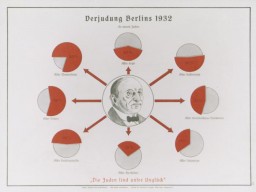
-
Jewish Losses during the Holocaust: By Country
ArticleBefore the Nazi rise to power, the countries of Europe had varied and vibrant Jewish communities. By 1945, two out of every three European Jews had been killed.

